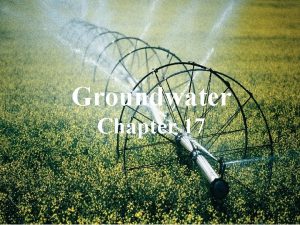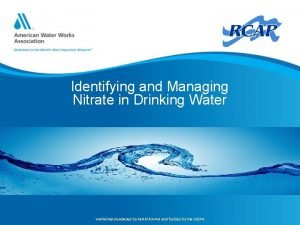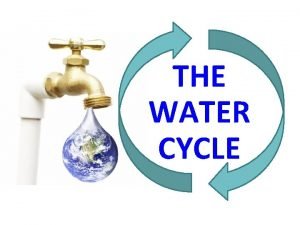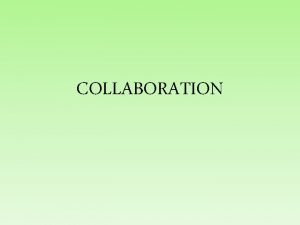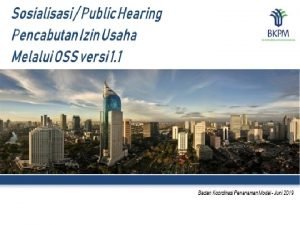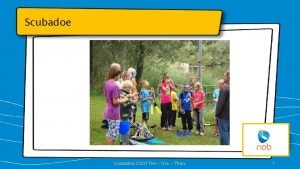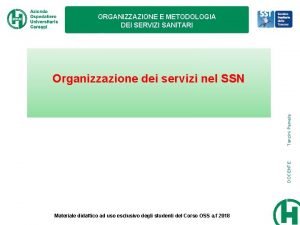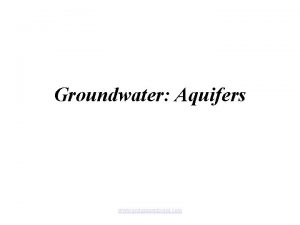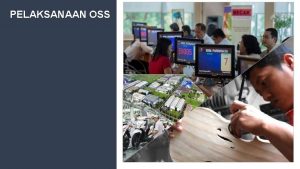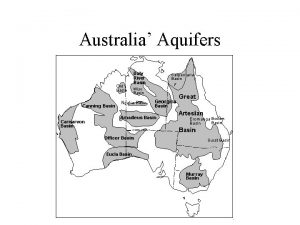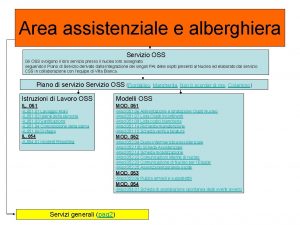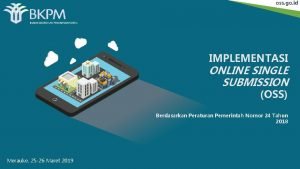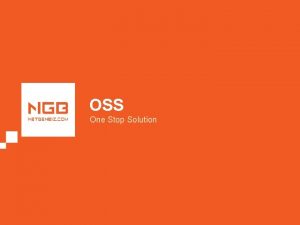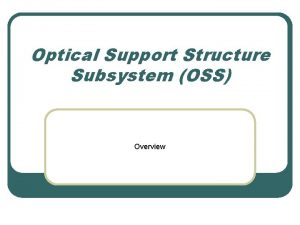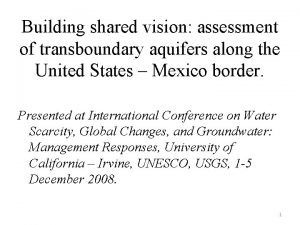MANAGEMENT OF SHARED AQUIFERS IN AFRICA OSS experience













- Slides: 13

« MANAGEMENT OF SHARED AQUIFERS IN AFRICA » OSS experience Tunis 4 -6 September 2017

OSS: AN INTERNATIONAL ORGANIZATION MEMBERS 23 African countries : North Africa: Algeria, Egypt, Libya, Morocco, Tunisia West Africa : Burkina Faso, Cape Verde, Côte d'Ivoire, Gambia, Guinea Bissau, Mali, Mauritania, Nigeria (since 2017), Senegal, Chad • East Africa: Djibouti, Eritrea, Ethiopia, Kenya, Sudan, Somalia, Uganda (soon 24 with Cameroon) ? ? ? • • 6 countries of the North : Germany, Belgium (since 2016), Canada, France, Italy, Switzerland 6 African S / R organizations : UMA, IGAD, CILSS, CEN- SAD, CBLTAPGMV 3 partner organizations of the United Nations : UNESCO, FAO, UNCCD 3 NGO : International Action and Achievement Center : CARI, The International Network Enda Third World (ENDA) , Sahel Desertification Network (RESAD) Intervention zone § North Africa [UMA + Egypt] § East Africa [IGAD] § West Africa [CILSS] Missions § A North-South Partnership Platform § An interface between political and scientific actions § An instrument available to member countries • • Two major axes: Water 1 of 7 Land

OSS Strategy 2020 A strategic framework § The different conventions • • OBJECTIVES …………. Improving the management of water and the land Increase resilience of populations Fighting poverty To strengthen spread and share knowledge § Regional and National Policies and Initiatives: (Agriculture, Water, Development) § Sustainable Development Goals:

Transboundary Waters in Africa 200 major transboundary river basins and lakes in the world, nearly 80 in Africa, including 55 major transboundary rivers 608 Transboundary aquifer systems around the world including 83 in Africa Several basin organisms for surface waters and some for groundwater

Shared waters in the OSS area § § 10 watersheds and 12 major transboundary aquifer systems 760 billion m 3 / year of renewable water resources More than 320 billion m 3 / year shared More than 155 billion m 3 / year exploited IN THIS CONFIGURATION, THE RESOLUTION OF THE WATER PROBLEMS OF THE REGION NEEDS NECESSARILY BY A CONCERTED MANAGEMENT OF TRANSBOUNDARY WATERS

The OSS Water Program Structured around 4 themes • Improved knowledge of large transboundary aquifers On qualitative and quantitative aspects, on surface water-groundwater exchanges, and on the impacts of climate change … • Support for the implementation of Integrated and Concerted Water Resources Management: Databases, GIS, hydrodynamic models, sensitization. . • Support for the creation of consultative mechanisms : Decision support systems and aspects of use. • Capacity Building • 3 HEADLIGHT PROJECTS AQUIFER SYSTEM OF THE NORTHERN SAHARA : Algeria, Libya, Tunisia: SASS and WADISMAR / FFEM and GEF projects AQUIFER SYSTEM OF IULLEMEDEN TAOUDÉNI / TANEZROUFT Algeria Benin, Burkina Faso, Mali, Mauritania, Niger and Nigeria: GICRESAIT / FAE project IGAD Zone: Djibouti, Eritrea, Ethiopia, Kenya, Somalia, Sudan, South Sudan and Uganda IGAD /FAE Project INTEGRATED WATER RESOURCE MANAGEMENT IN THE MAGHREB : CREM/ BMZ Project

The first OSS Phare project: The Aquifer System of the Northern Sahara Countries concerned : Algeria, Libya, Tunisia Area: 1. 000 km 2 Theoretical reserves (not very renewable) 60. 000 billion of m 3 Water requirement (m 3 /yr): 600 Million (1970), 2. 5 Billion (2000), 8 Billion (2030) Irrigated area (ha): 50. 000 (1970), 270. 000 (2014), 400. 000 (2030) Exploitation (m 3 /an): 0. 6 billion (1950), 3 billion (2016) Problems due to overexploitation of the water table Cooperation mechanism: • Salinization of water Coordination mechanism (2008) integrating the aquifer of the Djeffara plain • Disappearance of artesianism • Increase in pumping heights • Drying up of Tunisian outlet • Foggaras drying up in Algeria • Saline intrusion into the Gulf of Syrte (Libya) RESERVATIONS CONSIDERABLE BUT LOW RENEWABLE

The SASS approach PHASE 1: 1999 -2002 PHASE 2 : 2003 -2008 A BASIC APPROACH STUDIES § Improved knowledge of the aquifer system § Construction of a Common Information System • Socio-economic impacts § Creating mutual trust • Environmental impacts § Enhancement capacities § Involvement of policy makers • The operationally of the Coordination § Creation of a permanent tripartite mechanism at technical level Mechanism • Framework for consultation, created on the basis of a declaration by the PHASE 3 : 2010 -2015 • Objective: To improve the agricultural productivity of irrigation by rational exploitation of water potential and an improvement of production techniques PHASE 4 : 2018 -2022? ? ? Large-Scale Pilots Evolution of the Coordination Mechanism Ministers operational since 2008.

Adaptation of the SASS approach Iullemeden Taoudéni / Tanezrouft Aquifer (West Africa) § Africa's second largest aquifer: 2. 5 million km 2 after the Nubian Sandstone Aquifer (2. 6 million km 2) § 30 million inhabitants (10% of the total CEDEAO population) §A renewable water resource potential of 19 billion m 3 per year AN APPROACH § Improved knowledge § Construction of a Common Information System Cooperation Mechanism : § A study of the interactions between groundwater and surface water The Ministerial Meeting (March 2014 in Abuja , Nigeria) resulted in the "Ministerial Declaration" in which Ministers reaffirmed their will and commitment to cooperate in a regional SAIT-wide management, protection, conservation and equitable use of SAIT's water resources to best meet the requirements of development. § Enhancement capacities § Involvement of policy makers They also adopted the Memorandum of Understanding together with a roadmap for the setting-up of the consultative framework with a view to its ratification by the Member States and its immediate application. To date, the protocol has been signed by 4 out of 7 countries

Adaptation of the SASS approach IGAD sub-region (East Africa) Since 2010, the approach has been adapted to the IGAD sub-region, using the same initial principle: § Improved knowledge § Construction of a Common Information System § Enhanced cooperation between countries • • A first phase was completed in 2013. The second one has been prepared. It is awaiting the necessary funding 5. 2 Million de km 2 80% of the subregion is arid and semi-arid Population estimated at 206 million in 2010, 462 million in 2050 (6) major river basins and six (6) transboundary aquifer systems

Regional and thematic integration v Cooperation with CBLT Strengthen the resilience of the socio-ecological systems of the Lake Chad basin through the development of water resources and institutional strengthening v Cooperation with OMVS and OMVG Improving the management of groundwater resources in the Senegal-Mauritanian Aquifer System (SASM) in relation to the flow of rivers Senegal and the Gambia v Cooperation with ABN Improving the Governance of the Niger River Basin and the Iullemeden and Taoudéni / Tanezrouft Aquifer Systems (ITTAS) v Cooperation with ABN, CILSS, AGRHYMET, ACMAD: Preca-Sahel (project being reassembled): Resilience to climate disasters and capacity building of national and regional institutions

The objectives of the OSS in the field of transboundary water § § § Improve knowledge of water resources, including water costs § § Identify adaptation measures to climate variability, § § § Strengthen cooperation and exchange of information between countries Better value for water to contribute to poverty reduction Establish master plans for the integrated management of water resources by transboundary watershed within 20 to 30 years Encourage, as far as possible, the use of renewable energies and in particular solar energy to reduce the cost of water produced from other energies. Promoting Integration Water - Energy - Food Security - Health Continue / encourage the implementation of integrated water resources management in developing countries

Thank you for your kind attention ! www. oss-online. org https: //twitter. com/OSS_Comms http: //www. facebook. com/groups/osscommunity http: //www. linkedin. com/groups/Sahara-Sahel. Observatory-OSS-4908101
 Importance of groundwater
Importance of groundwater Aquifers and springs
Aquifers and springs Us aquifers
Us aquifers Underground water table diagram
Underground water table diagram The shared experience of absurdity worksheet
The shared experience of absurdity worksheet Imprinting meaning psychology
Imprinting meaning psychology Early experience vs later experience
Early experience vs later experience Direct and indirect experience examples
Direct and indirect experience examples Cara mencabut izin usaha di oss
Cara mencabut izin usaha di oss Duiken tiel
Duiken tiel Netflix microservices
Netflix microservices La metodologia
La metodologia Oss unist
Oss unist Upisi.hr oss
Upisi.hr oss
